
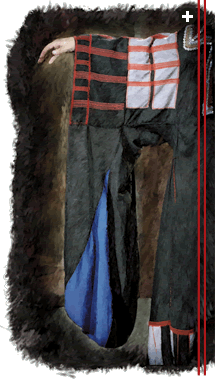 |
| The Harb tribe lives around Madinah, in the Hijaz, the western region of Saudi Arabia. The English traveler Charles Doughty may have referred to such dresses in 1870 when he described a Harb woman “in her calico kirtle of blue broidered with red worsted.” The trademark of the Harb is indigo blue with a combination of patchwork, buttons and embroidery. |

 ff a back street in the highland city of Taif, near Saudi Arabia’s Red Sea coast, Um Saad pulls black cloth dresses from a trunk in a rooftop room of her simple cement-block house. Each dress is heavily embroidered, beaded or appliquéd in white and bright reds, oranges and yellows. As she shakes them out, fragrant dry sprigs of sweet basil, stored with the clothes to protect them against moths, fall to the floor. Um Saad helps a visitor don one of them—it’s the wedding dress of Um Saad’s daughter. Watching studiously are half a dozen women, several of them taking photographs or sketching, especially as Um Saad explains how the seven-part headpiece is worn.
ff a back street in the highland city of Taif, near Saudi Arabia’s Red Sea coast, Um Saad pulls black cloth dresses from a trunk in a rooftop room of her simple cement-block house. Each dress is heavily embroidered, beaded or appliquéd in white and bright reds, oranges and yellows. As she shakes them out, fragrant dry sprigs of sweet basil, stored with the clothes to protect them against moths, fall to the floor. Um Saad helps a visitor don one of them—it’s the wedding dress of Um Saad’s daughter. Watching studiously are half a dozen women, several of them taking photographs or sketching, especially as Um Saad explains how the seven-part headpiece is worn.
The visitors all belong to Mansoojat, an all-volunteer organization whose name is Arabic for “textiles,” founded in 1999 by nine women from Jiddah, seven of whom are cousins in the Alireza family. In the past four years, they have pooled their personal collections of Arabian embroideries, beadwork and traditional costumes, and together have given new life to nearly extinct arts of handcrafted textiles in Saudi Arabia.
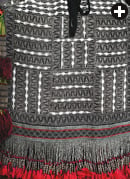 |
The trailing back panel of this headdress from the Bani Saad tribe, in the area around Taif, is heavily embroidered with lead beads in geometric designs and finished with an edge of red tassels. |
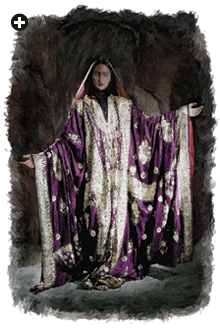 |
This antique thawb (gown) of purple silk with gold embroidery is a type found in Najd, the central region of Saudi Arabia, and in the Eastern Province. It would have been worn by a married woman to a wedding or an important social event. |
A spry, grandmotherly woman, Um Saad is a specialist in the vanishing embroidery and beadwork of the Bani Saad tribe, one of the many from the Hijaz, the western region of Saudi Arabia. With the Mansoojat delegation are Dr. Zainab Dabbagh, advisor to the master’s degree program in traditional clothing at Jiddah’s King ‘Abd al-‘Aziz University, and Laila Feda, a doctoral candidate from the College of Home Economics and Art Education in Riyadh.
Mansoojat’s goal, explains member Sultana Alireza, is “to preserve what was quickly dying and disappearing, from the costumes and the embroidery to the way the dresses were worn.”
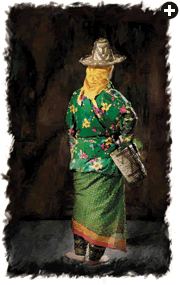 |
Dresses from the fertile hills of the Abha region, in the south of Saudi Arabia, are often made from fabric printed in floral patterns. When working on the land, the women of Abha tie their hems around their waists to keep them clean, while a sarong wraps over the pantalets—embroidered near the ankles—which protect against the mountain chill. A straw hat over a colorful scarf wards off the harsh sun. |
Although the group has now collected nearly 300 costumes, headpieces and accessories, the hardest part has turned out to be learning how they were worn, explains Hamida Alireza, a founding member and volunteer curator. With the exception of the urban clothing from Makkah, she says, the collective memory of the members of Mansoojat does not include the mode of dress for most of the costumes, which come from every corner of the Arabian Peninsula. “For some, we have been able to use old pictures. From a picture in Thierry Mauger’s book Heureux Bedouins d’Arabie, we found that the women of the Rub’ al-Khali wore skeins of wool in a turban with their dresses. Sometimes we rely on the antique clothing dealers downtown, but sometimes they give you a song and dance, because of course they are all men, and they often haven’t a clue how the costumes were worn. Some things are obvious, like the headdress that fits on the head and comes down in a rectangle on the back. However, the headdresses of the Bani Saad are quite complicated, comprising seven different pieces!”
With the cameras clicking, Um Saad sits down and picks up a piece of needlework in progress, a black fabric panel half covered in a heavy, beaded design. Laila Feda is completing her dissertation and has widely traveled the Hijaz, searching out costumes on the verge of extinction. For her, Mansoojat and the costume collection of the Al-Nahda Women’s Society in Riyadh have proven invaluable. She sits close and sketches on a pad, noting the order of the in and out points as Um Saad’s henna-stained hand quickly guides the needle through the thick black cotton cloth, trailing a bright red thread. Without a pause, her needle picks up one tiny lead bead from a small dish filled with them, and she anchors it to the fabric with a stitch.
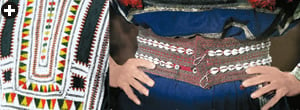 |
Left: The chest panel of a costume from the Bani Saad tribe contours the embroidery by interspersing small, white glass beads with red thread knots.
Right: A belt from the Wadi Mahram area between Taif and Makkah uses cowrie shells to embellish the embroidery. Bead trading thrived in the Arabian Peninsula for millennia, and cowrie shells hark back to the days when such shells were a form of currency, mainly in the Indian Ocean trade.
|
“I have been fascinated with traditional dresses since I was a child growing up in Makkah,” Feda says. “Throughout my studies in fashion and design, whenever I went to the library, here or abroad, I would find many books documenting traditional clothing from around the world. Not only did I find almost nothing about Arabian traditional clothing and embroidery, but one international authority on textiles and embroidery— Sheila Paine, the author of Embroidered Textiles: Traditional Patterns from Five Continents—devoted just one sentence to the dresses of the desert tribes of Saudi Arabia, describing them as being ‘of black cotton—decorated with minimal embroidery.’ The tribal dresses are usually more than two-thirds covered with embroidery in bright colors!” Like the women of Mansoojat, Feda is determined to bring the intricate wonders of Saudi costume to the attention of not only the wider world, but also her fellow Saudis.
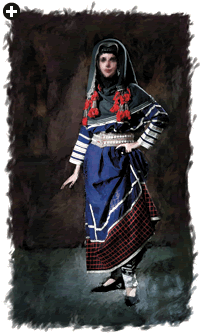 |
In this dress from Wadi Mahram, near Taif, colored cotton and gold embroidery alternates with plain bands of fabric, and the cuffs are also embroidered with white, red and gold thread. |
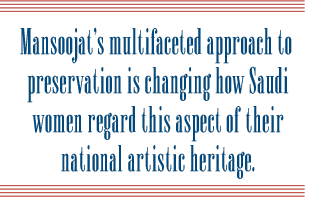 Dabbagh, one of Saudi Arabia’s first female Ph.D.’s, was also one of the first people to recognize that the last half century’s social and economic changes in Saudi Arabia were rapidly pushing many aspects of Arabian cultural heritage to the brink of extinction.
Dabbagh, one of Saudi Arabia’s first female Ph.D.’s, was also one of the first people to recognize that the last half century’s social and economic changes in Saudi Arabia were rapidly pushing many aspects of Arabian cultural heritage to the brink of extinction.
“We realized the need to catch the traditional ways,” Dabbagh says. “Since 1982 we have incorporated the study of the traditional ways, in housing, child-rearing, medicine, etiquette and of course in clothing, into our programs at the university as a way to preserve our heritage.”
In staging several public costume exhibitions with nearly 60 models in traditional costumes—complete with authentic accessories, jewelry and headdresses—Mansoojat has found, as Hamida Alireza notes, “utter amazement” on the part of the public. More than once she has heard viewers exclaim, “These [costumes] are from here?”
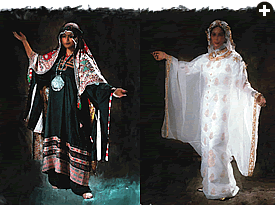 |
Left: The Sulaym tribe is related to the Harb and also lives near Madinah, but the Sulaym do not use indigo. This exquisitely embroidered dress has a quilted hem to protect against thorny bushes.
Right: This fitted dress embroidered in gold thread and covered with a sheer thawb is something a Makkan woman might wear on festive occasions. The head cover is also embroidered in gold thread and shows a Turkish influence. The bodice and drawstring pantalets underneath are “Indonesian style,” showing yet another influence of pilgrims on Saudi styles. |
After a few hours with Um Saad and her handiwork, the women pile into their cars and head across the city of Taif toward the home of a woman who has become one of Mansoojat’s most valued sources. Affectionately they call her Madame Kurat— “Madame Chives.” Hamida explains: “We were in the Bedouin market when the dhuhr prayer was called, and the shops closed. We had only found a few pieces that were authentic and handmade. We had started looking at our purchases in the middle of the street when a woman came up to us carrying an enormous bag of chives. Pointing to our textiles, she said, ‘Do you want more like these?’ She hopped in the car with us, took us to her home, and there we found both her daughter and her daughter-in-law embroidering. So we bought pieces from them, and we later gave them commissions. It was the beginning of a wonderful relationship.”
As the women seat themselves on the worn but clean carpet, Magboula, Madame Kurat’s daughter, pulls out several panels completely covered in row after row of varied herringbone stitches and lead beadwork in the style of the Bani Saad tribe. Amna Alireza, the artistic director of Mansoojat, has commissioned these to be incorporated into a line of designer handbags to be manufactured in Mansoojat’s own workshop. Combining modern and antique panels with Victorian handles, these will be sold at a public exhibition held in a jewelry boutique.
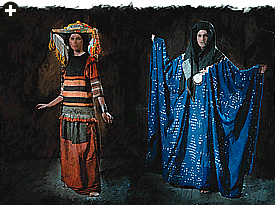 |
The Jahdaly tribe lives between the town of Lith, on the Red Sea coast, and Makkah, farther inland, and its women’s clothing is made of red muslin, locally dyed, and imported brown muslin, lined with rough fabrics salvaged from flour sacks. |
When Hamida first met Madame Kurat in 1999, Magboula’s daughter, who was then 12, knew almost nothing of sewing. Something about the contact with Mansoojat changed this, because three years later, the girl presented Hamida with an embroidered panel for a dress or a purse and asked if it might be sold as a modern sample of a traditional style. “It was absolutely wonderful,” says Hamida.
“Initially part of the mission of Mansoojat was to create jobs locally for women by rejuvenating the art and creating a market,” explains Sultana Alireza, who helps coordinate the commissioned work. “We hoped to motivate the women who were already doing the embroidery to keep stitching and to teach their daughters and start handing this craft down as it was done in the past.” Out of this desire, the Mansoojat Embroidery Workshop was born three years ago along the lines of a social club, and now some 20 young women meet three afternoons a week.
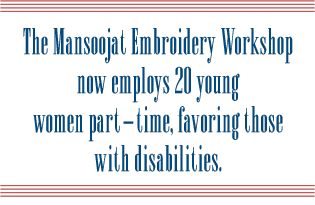 By stimulating a market for the women’s pieces, Mansoojat has encouraged them to follow the lead of Madame Kurat’s family. Once again, as it was decades ago, decorative embroidery has become part of daily life, and now it is also a lucrative business. Mansoojat’s exhibition of handbags sold out in the first two hours of the first day. Another exhibit showed artwork that incorporated Amna Alireza’s contemporary painted canvases and traditionally embroidered panels: The women who created the panels each received a commission for each piece, and since then the demand for the items, mostly by word of mouth, has staggered the women.
By stimulating a market for the women’s pieces, Mansoojat has encouraged them to follow the lead of Madame Kurat’s family. Once again, as it was decades ago, decorative embroidery has become part of daily life, and now it is also a lucrative business. Mansoojat’s exhibition of handbags sold out in the first two hours of the first day. Another exhibit showed artwork that incorporated Amna Alireza’s contemporary painted canvases and traditionally embroidered panels: The women who created the panels each received a commission for each piece, and since then the demand for the items, mostly by word of mouth, has staggered the women.
“We don’t keep any stock, and the pieces have just been flying off the shelves,” remarks Sultana. Another successful product that incorporates the traditional embroidery is customdesigned clothing. “People enjoy ethnic things now,” observes Sultana. “I think that people are tired of the Guccis and Fendis, which don’t really make a statement—but something that has a cultural and ethnic history behind it, something that you can feel and something that you can wear forever that never goes out of fashion— and when you are tired of it, you put it away and wait to give it to your daughter—there is a great interest in those kinds of pieces today.”
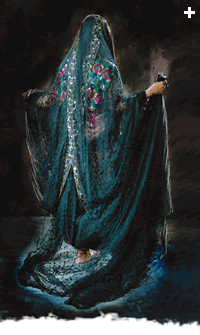 |
This is the back of the purple silk thawb shown above. With the wearer’s arms extended, its sleeves measure nearly five meters (16') from wrist to wrist, and can be pulled up to serve as a head cover as well. |
With this budding, promising market, Mansoojat began to focus more seriously on jobs. “We added another angle, which was to hire girls who did not have embroidery in their backgrounds, urban girls or even girls from rural areas who had graduated from school and could not find jobs,” says Sultana. “We took it a step further and asked, ‘Who are the girls who are the least likely to find jobs?’ And we decided that it was girls who had disabilities.”
Now, Selma Alireza, who is the workshop coordinator and a stitchery specialist, works with a contemporary embroidery artist to teach the girls. “It has been just wonderful to watch that teacher, who had never met a deaf person in her life, suddenly teaching 20 deaf girls how to stitch,” says Sultana. “What is amazing is that each and every one of the girls had talent, and they all came to us with zero, absolutely zero, experience with needle and thread, so there were no criteria for hiring them. There is talent in everyone. Just put them in the right environment and give them the opportunity and inspiration, and then just sit back and see what happens.”
Mansoojat’s multifaceted approach toward preservation appears to be a recipe for success. At its 2002 costume exhibition, several hundred women overfilled the hall, anxious to see for themselves the textile heritage that has come so close to being entirely lost. As the lights dimmed, the commentator voiced Sultana’s founding vision: “We invite you to join us tonight in reclaiming our past, and thereby ensuring our future.”
 |
Free-lance photojournalist and digital artist Samia El-Moslimany ([email protected]) is also the owner of Photography by Samia, a portrait studio in Jiddah, where she returns regularly from her current home in Seattle. |
This article appeared on pages 60-65 of the Compilation Issue 2008 print edition of Saudi Aramco World.
Check the Public Affairs Digital Image Archive for Compilation Issue 2008 images.





